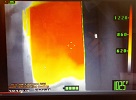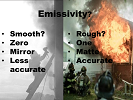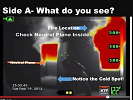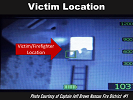By Andy J. Starnes
In the fire service today, we are rapidly learning and adapting to new technologies and working hard to stay ahead of the dynamic world in which we serve. Since the late 1990s, many fire departments have been using thermal imaging cameras. What is tactical thermal imaging all about? Why is it important? Is this some new-fangled lingo for something the fire service is already doing?
Tactical thermal imaging can be compared to a paradigm shift. It is taking the knowledge, skills, and training we already have and enhancing them by adding another perspective: the thermal perspective. Many incidents we face could be enhanced and made more efficient by additions that can reduce the loss of lives. Thus, tactical thermal imaging can be defined as the use of a thermal imaging camera (TIC) to better diagnose the immediately dangerous to life or health environment to assist with strategic decision making. The information gleaned from Tactical TIC use can assist us in all aspects on the fireground such as the following:
• Size-up (Tactical 360).
• Identifying and managing the flow path.
• More efficient stream placement and interior fire attack efforts.
• Enhanced search methods and more.
Why is Tactical TIC use important?
In today’s thermal environment, we consistently see rapid fire progression resulting in flashovers and early structural collapse in lightweight construction. Flashovers are occurring as quickly as a few minutes from ignition. The National Institute of Standards and Technology, Underwriters Laboratories, and Project Kill the Flashover have revealed numerous test results that prove that today’s furnishings and contents contribute to rapid fire progression as a result of higher heat-release rates.
As the environment has changed, the fire service has improved firefighter gear with higher thermal protective performance to shield them from thermal insult longer, creating an illusion of superiority in a rapidly progressing thermal environment. Thus, today’s thermal environment demands a diagnostic tool that allows firefighters to prevent thermal insult, identify and locate the fire’s severity, and locate any victims or firefighters quickly.
Those who advocate that firefighters wait to feel the heat to indicate their level of safety should read and remember the following:
• Most fuels are pyrolyzed at 600˚ to 930˚ F.
• Carbon monoxide ignites at approximately 1,100˚ F.
• The polycarbonate of a self-contained breathing apparatus mask begins to fail at 446˚F.
• Firefighter personal protective equipment (PPE) begins to fail 572˚F.
• Minimum thermal protective performance of turnout gear provides 17.5 seconds of protection before a firefighter receives a second-degree burn.
Traditionally, TIC usage has been for search and overhaul applications. Yet, TICs can be used in so many more applications such as EMS incidents, hazardous-materials incidents, wildfire incidents, missing persons, and enhancing our strategies and tactics on the fireground. Keep in mind that implementing Tactical TIC use doesn’t replace our foundational skills; it greatly enhances them.
Today’s thermal environment is vastly different than 20 years ago. With newer lightweight construction techniques, Green & LEED certifications, that focus on more synthetics and glues along with contents that have dramatically higher heat-release rates, the modern fireground is one of rapid fire progressions with dramatic changes in a matter of seconds. In our new paradigm of the fireground, we need to be aware of the thermal data and how they impact us. We can greatly benefit from diagnosing the location and severity of the fire prior to launching our attack–for example, as a forward-thinking incident commander, I believe we can greatly benefit from forecasting the speed and direction of fire spread.
As a crew leader we can greatly benefit from protecting our crews from thermal insult by monitoring the thermal environment and the thermal saturation rate of their PPE. As a search team, we can greatly enhance our effectiveness by understanding and implementing tactical TIC use. We need to be aware that the environment we are entering may exceed the protection of our PPE if conditions are not properly mitigated. From a thermal perspective, many firefighters often don’t understand the severity of what they are seeing. Heat-release rates are 15 times greater in today’s fire environment compared to legacy fires. Therefore, we have 15 times less time to mitigate or respond to the situation. The question we must ask ourselves is, Without a thermal diagnostic tool such as the TIC, how can we adequately respond to this rapidly changing thermal environment?
Firefighters who understand field of view, color palettes, temperature vs. function modes, resolution, distance to spot ratio, and emissivity can greatly enhance their effectiveness on the fireground.–these are the key attributes for interpreting the image displayed on the TIC’s screen.
Field of View (FOV)
The field of view is the windshield through which we view the incident. This view is often between 37˚ (vertical) and 50˚ (horizontal). The human eye sees approximately 270˚ FOV, which means we are missing a large part of the incident scene if we do not scan the area accordingly. In photo 1, notice the difference between the FOV between the TIC’s view and the helmet cam’s view. This emphasizes the importance of understanding the FOV of your TIC.

(1) Field of view. (Photos courtesy of author.)
Modes and Color Palettes
The temperature and function modes of the TIC determine the range of the color pallet and its usage. For example, many TICs have up to five functional (user specific) and up to three temperature modes. A firefighter must be trained to interpret the image based on the functional mode of the TIC and the associated color palette dependent on the temperature mode it is in. In relation to temperature, a TIC will typically operate in two modes: high and low sensitivity. The higher sensitivity mode provides greater detail in lower-temperature environments, which can be 300˚F and lower. The lower sensitivity mode provides greater clarity at higher temperatures, which can be 500˚ up to 2,000˚, dependent on the brand of TIC. In the lower sensitivity mode, darker colors that would typically be associated with cooler temperatures can be very hot. A firefighter who sees a dark or gray area outside of a fire room may mistakenly associate that color with safety when it can be as hot as 500˚ to 600˚F (photo 2).

(2) The outside of a fire room that is dark gray. This TIC is in the low sensitivity mode, indicated (in this case) by a green triangle in the upper left-hand corner of the screen.
Resolution
If you don’t know the resolution of your TIC, it can mean the difference between making a save or a miss. The majority of TICs on the market today fall into three ranges of resolution: 160 ×120, 320 × 240, and 384 × 288. Why is this important? From the following, you can see why the resolution is important to the crew leader:
· 160 ×120 resolution: A victim’s hand is visible at seven feet away.
· 320 × 240 resolution: A victim’s hand is visible at 15 feet away.
· 384 × 288 resolution: A victim’s hand is visible at 20 feet away.
For example, a crew searching a 12 ×12 bedroom using the directed search method would miss a small child’s hand if it were more than seven feet away. What if we miss a small hand-sized ember burning in the wall or attic in overhaul?
Distance to Spot Ratio
Distance to Spot Ratio is the TIC’s ability to successfully measure a spot temperature (the crosshairs or focal point) from a specific distance. The effective range a TIC measures accurately at the focal point is typically a 12-inch circle. This can be compared to a flashlight beam. As you stand closer to the wall with the flashlight, the beam is more focused and intense (more accurate). As you walk farther away, the spot becomes larger and less intense (less accurate). An individual holding a TIC should be aware of the TIC’s distance to spot ratio to accurately diagnose the thermal environment and should read the entire image, not merely the spot temperature.
For example, an incident commander may conduct a 360˚ and view a temperature of 500˚F at the door from 15 feet away. As the entry team prepares to enter, they view a temperature of 1,000˚F just inside the door. The difference in temperature can be caused by the distance to spot ratio and the focal point of the user. If both users do not aim at the same exact spot at the same time in the fire’s growth, the temperature will be different. This is where a laser pointer on the TIC can help. Why is this important? It’s a spot temperature measurement, not of the overall thermal environment; many firefighters have suffered rekindles for failing to recognize this!
Emissivity
Emissivity affects the radiation in a way that can make the surface or gas appear to have a temperature different from what it actually is. Firefighters can be fooled by an object with a lower emissivity giving a false temperature reading. In general, surfaces that are black in color and somewhat rough in texture have high emissivities; surfaces that are shiny or smooth in color/texture have low emissivities (photo 3). Most fire service TICs are set at an emissivity level of 0.95 in their internal algorithms used to convert the radiant energy signal into a temperature value. The further away the object’s emissivity value is from 0.95, the less accurate that object’s surface temperature will be.
An object can emit, absorb, or reflect heat. Any object above the temperature of absolute zero in degrees Kelvin emits thermal energy. Emissivity ratings are defined as a fraction of energy (rated between zero and 1) in comparison to a perfect black surface, which has an emissivity value of 1.

(3) Each TIC has a specific emissivity setting based on the objects it will measure. Most thermal imagers are set at 0.95 emissivity, the same as that for carbon or soot. A material or an object with an emissivity rating of zero would be considered a perfect mirror, which would reflect heat and provide a false reading on a TIC. Some examples of these materials would be tin metal exteriors or roofing, concrete walls/floors, stainless steel, glass, and gypsum board (which explains the rapid radioactive feedback loop we see in fire development). In our firefighting training, we have been taught, whether it’s vapor density or specific gravity, to make comparisons based on a numerical rating between 0 and 1; thus this knowledge should fit neatly into our synaptic shelves.
The Application
In the realm of firefighting, if we don’t offer an experientially relevant example to our firefighters, the subject matter will lose all relevance. Following is an example of the implementation of tactical TIC use on the fireground. At the majority of fireground incidents, a 360˚ walk-around will be attempted or conducted. In photo 4, you can now apply the information you have learned and enhance your strategies and tactics.

(4) As a first due arriving incident commander, the value of thermal data is increasingly important. We can now see the thermal severity of the fire (post-flashover temperatures are evident). We can see the progression and location of the fire as well as the direction of the fire spread by reading the color palate. We can identify the neutral plane, which is indicative of the fire’s growth, as well as identify the flow path (bi-directional flow in this photo). This is but one example of the application of tactical thermal imaging.
As we progress through the sequential tactical steps of firefighting, let us consider how we can enhance those tactics. We can now identify the location and severity of the fire. We can now identify possible victim locations as well as fire progression so we can address our rescue efforts accordingly (photo 5).

(5) Identifying thermal signatures in tightly sealed new construction enable us to more efficiently place hoselines and streams. We can enhance our search efforts by understanding the temperature modes of the TIC. Many firefighters are trained to view a victim or a firefighter’s body as a white hot signature on the viewing screen. However, in a superheated environment a 98.6˚F body will be viewed as a dark image– not a white, hot, and easy-to-locate image.
The application of tactical thermal imaging is limited only by the user’s knowledge and training. The technology is available, and we should remain fundamentally sound while enhancing our decision-making skills through the tools available to us. We owe it to ourselves and to those we have a duty to protect to stay current on the available technology that can save lives.
BIO
Andrew J. Starnes is deputy chief for the Kill the Flashover Project and a lifelong student of the fire service, which he joined as a volunteer in 1992. He became a career firefighter in 1998. He is a Web site author of articles on the topics of thermal imaging, fire behavior, leadership, behavioral health, and faith-based devotions for Firefighter Toolbox, Fire Department Concepts, Carolina Fire Rescue Journal, and Fellowship of Christian Firefighters. He is the founder of www.bringingbackbrotherhood.org, a non-profit organization designed to encourage and provide guidance for firefighters in the areas of behavioral health and counseling. He instructs regularly on modern fire behavior. He has been featured on the firefighter training podcast moderfirebehavior.com.

